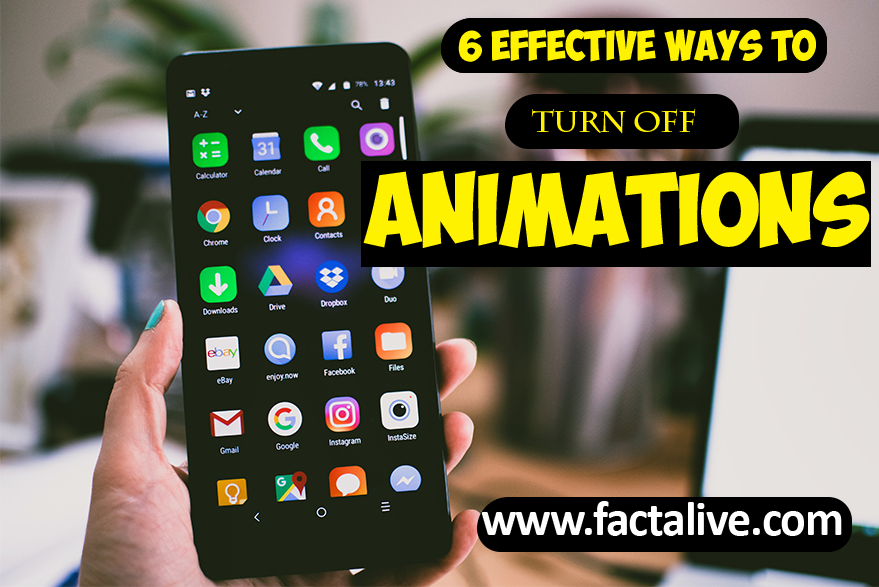Tired of your Android device’s sluggish performance? Say goodbye to lag and hello to a smoother, faster device. Whether you’re navigating between apps or opening menus, we’ve got the inside scoop on how to disable animations and optimize your phone’s performance. Don’t let your device hold you back – discover the secrets to a faster Android now.
nanadwumor

- Visual and motion effects
- Screen transitions
- App launches
- Notification panel
- Pop-up messages
- Enhance user experience
RECOMMENDED ARTICLES
Check Out How You Can Make a Simple Basic Phone with Free Software
Transform your old phone into a sleek, minimalist device with LineageOS and F-Droid. Learn how simple tweaks can make your outdated gadget feel modern and efficient. LineageOS for Old Phones: LineageOS replaces old phone...
OpenAI seeks to make its upcoming ‘open’ AI model best-in-class
Toward the end of March, OpenAI said it intended to release its first “open” language model since GPT‑2 sometime this year. Now, details about that model are beginning to trickle out from the company’s sessions with the AI developer c…
Do You Gain or Lose Anything From Using Ad Blockers?
Ad blockers aren’t perfect, but they shield you from fraud and hidden trackers Blocking ads can reduce creator revenue Some ad blockers allow selective ads Check ad blocker privacy policies...
Do you wish to accelerate your Android device? We’ve uncovered a distinctive method that can significantly enhance your phone’s speed. There’s no need to bother with clearing caches or managing RAM. The solution lies in disabling all animations on your phone, which can dramatically boost your user experience. With animations turned off, you’ll witness faster loading times for apps, menus, pop-ups, and more, making your device feel snappier than ever before.
Is your Android device experiencing lag and sluggish responsiveness? If so, this trick can be a game-changer for you. This article will delve into the world of animation scales, a concealed feature within Android’s Developer Options settings. You’ll gain insights on how to access and leverage these scales to enhance your device’s performance. Without further delay, let’s dive in!
What Are Android Phone Animations and How Do They Impact Your Device?
Android phone animations encompass dynamic visual and motion effects that manifest during actions like transitioning between screens, launching apps, scrolling through content, accessing the notification panel, or encountering pop-up messages. These animations are integral components of Android’s user interface (UI) and app interfaces, designed to enrich the user experience through the delivery of fluid transitions and captivating visual effects.
How to Disable Animations on Android
Boosting your Android’s performance is a breeze when you know how to disable animations. This begins with enabling Developer Options, which are the concealed settings on Android that empower you to fine-tune system behavior, debug apps, and optimize performance. The following steps will guide you through the process of activating Developer Options and subsequently turning off all animations to enhance the speed of your device.
Step 1: Turn on Developer Options
To begin, launch the Settings app on your Android device, and navigate to the ‘About Phone’ section, which can typically be located either at the top or the bottom of the settings menu. Here, you’ll find the ‘Build Number’ option; give it seven consecutive taps. On Samsung smartphones, you’ll find the ‘Build Number’ within the ‘Software Information’ section. For Xiaomi, Mi, and Redmi devices, this same build number can be found under the name ‘MIUI version.’
As you tap on the ‘Build Number,’ a dialog box will pop up, displaying the message: ‘You are X steps away from being a developer.’ Once developer mode is successfully activated, a message confirming ‘You are now a developer!’ will appear. Depending on your device’s security settings, you may be prompted to enter a PIN, passcode, or draw a pattern lock if necessary. If your device already has Developer Options enabled, you will receive a different message, indicating: ‘No need, you are already a developer.
Please note that the steps provided above may vary slightly depending on the specific model of your phone and the version of the Android operating system it runs.
Step 2: Open Developer Options
Next, you’ll need to locate the newly enabled Developer Options in your device’s Settings. Open the Settings app, and scroll down to the bottom of the screen. There, you will find Developer Options positioned just above the ‘About Phone’ section. It’s worth noting that this option has been enabled in the previous step. If, for some reason, you can’t locate it on the main settings page, particularly on devices like Xiaomi, Redmi, or Mi smartphones, you may need to explore within the ‘System’ or ‘Additional Settings’ sections. Once you access Developer Options, you’ll notice a toggle button at the top, which is typically enabled by default. If it’s not enabled, simply switch it on, and you’re all set to make use of Developer Options
Step 3: Distroy all Android Animations
Within Developer Options, you’ll discover an array of features, each neatly categorized under different headings. Scroll through the list and find the ‘Drawing’ section; it’s here that you’ll encounter the ‘animation scales.’ Our objective is to modify the settings of these three options:
- Window animation speed: This setting dictates the velocity of window animations, such as the appearance of menus on your screen.
- Transition animation pace: Responsible for managing the swiftness of transitions between screens, like when you interact with settings options.
- Animator duration rate: This aspect controls a range of animations throughout your Android device, encompassing the launching and closure of applications, the act of accessing the notification panel, and more.
By default, these settings are configured with a 1x scale value. However, you have the flexibility to adjust them by tapping on these options, offering a range from .5x to 10x. Opting for a higher value will yield slower animations, while choosing a lower value will result in quicker animation effects. For instance, setting the animation scale to 10x will cause everything to load at a sluggish pace. Conversely, a setting of .5x will minimize animation effects, resulting in improved speed and performance for your phone. If you prefer, you can even completely disable these animation scales, further enhancing the overall speed of your Android device.
Step 4: Test your Phone’s Speed
Try opening any app from the app library or home screen and you will notice that it’s now loading faster. Likewise, when you open the Recent Apps tab from the navigation menu, it will feel like your phone is responding quickly than before. When all animations are disabled, there will be no transition between screens, or when open the apps. If you don’t like this effect, you can change the animation scales to 1x again or try other values.
Frequently asked questions
Does your battery life improve after disabling animations on your android phone?
Yes, while it does have a positive impact on battery life, the difference is often relatively subtle and may not be immediately noticeable. Battery usage is substantially affected by various other prominent factors, including background processes, the simultaneous use of multiple apps, screen brightness settings, connectivity features, and more. For a comprehensive understanding of optimizing your device’s battery life, we recommend exploring our in-depth guide dedicated to this topic.
Is it advisable to disable animations on Android?
Should your Android device run seamlessly, there’s typically no imperative requirement to disable animations. However, if you happen to possess an older device with limited RAM capacity, which exhibits sluggish performance in fundamental tasks such as app launching and screen transitions, then it may be worthwhile to consider minimizing or turning off animation effects.
Can you turn on animations again?
If the altered user experience isn’t to your liking, you can easily re-enable the animations. Just follow these steps: Navigate to Settings > Developer Options. Locate ‘Window Animation Scale,’ ‘Transition Animation Scale,’ and ‘Animator Animation Scale.’ For each option, select and set them back to the default value of 1x.
Conclusion
This simple yet effective trick offers a means to enhance your Android device’s speed by deactivating animations. Conversely, you can intentionally decelerate the device by cranking up the scale value for each animation to 10x. It’s worth noting that this trick remains concealed within the Developer Options, known to only a select few. You can even use it for some playful pranks on your friends; slow down their device animations and let them puzzle over why their phone seems unresponsive. And, of course, don’t forget to share this guide with them, so they can swiftly restore the settings. If you have any queries or require further assistance, feel free to post your questions in the comments below.
Join Our Telegram Group
Join Our WhatSapp Group
You May Also Like…
Check Out How You Can Make a Simple Basic Phone with Free Software
Transform your old phone into a sleek, minimalist device with LineageOS and F-Droid. Learn how...
OpenAI seeks to make its upcoming ‘open’ AI model best-in-class
Toward the end of March, OpenAI said it intended to release its first “open” language model since GPT‑2 sometime this year. Now, details about that model are beginning to trickle out from the company’s sessions with the AI developer c…
Do You Gain or Lose Anything From Using Ad Blockers?
Ad blockers aren’t perfect, but they shield you from fraud and hidden trackers [Sassy_Social_Share...



0 Comments